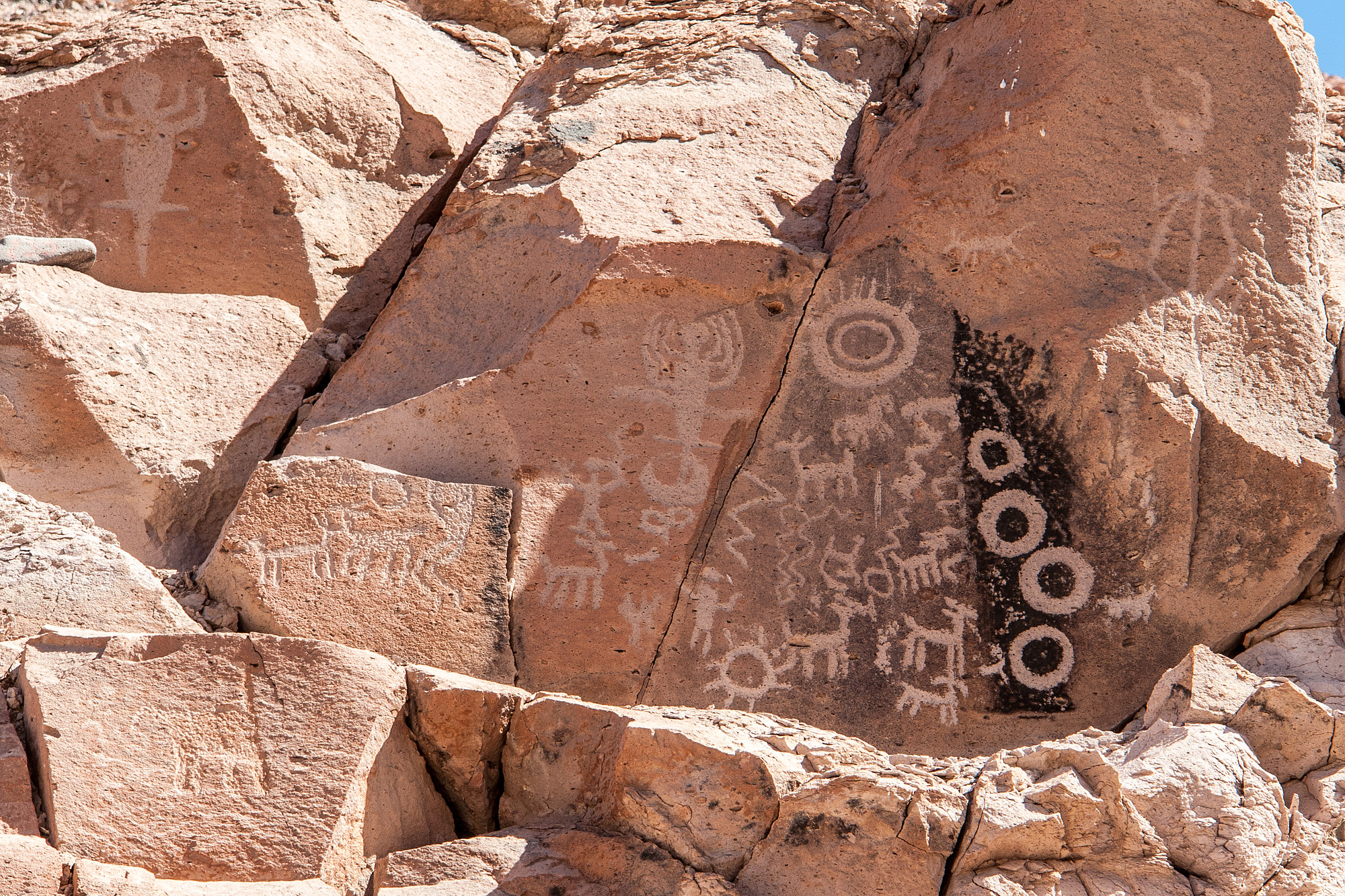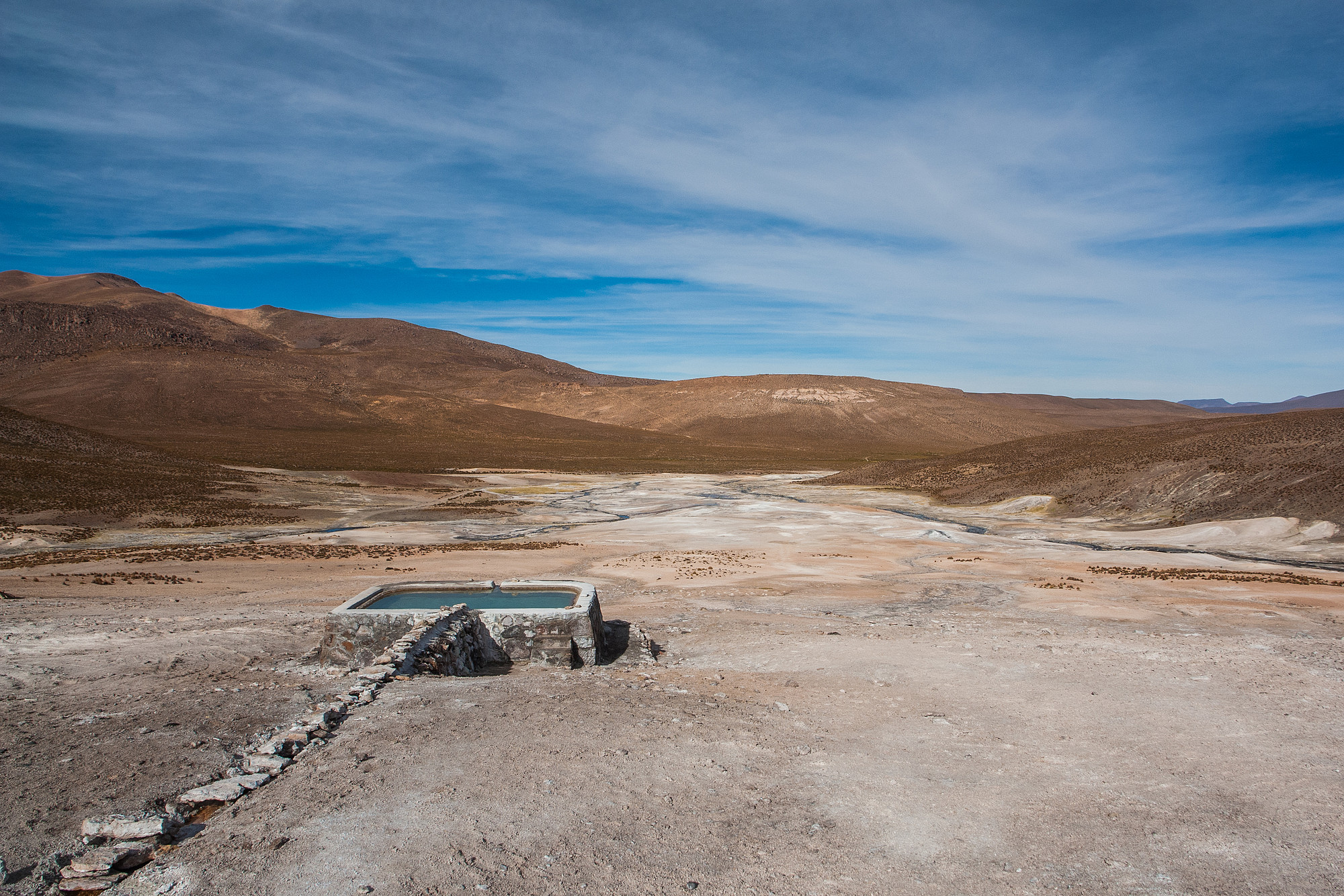The thermal water mainly felt warm because my head sticking out above the bath was almost freezing. With the wind howling among the hills, not much was needed to get an ear infection or pneumonia I figured while getting out of the concrete tank filled with water flowing down from a natural spring higher up the hill. I ran a towel up and down my body and threw my clothes on before my body froze. Despite the temperatures, the bath had been welcome and refreshing after yet another day of driving in the dust.
We were camped at almost 14,000 feet in the Andes Mountains, at the Puchuldiza Geysers. Even though it was summer, we woke up with ice on the inside of the windows of the Land Cruiser. I looked at my surroundings with fresh eyes. We stood on a lonely plateau amidst a solitude of bare mountain slopes and spouting geysers, their spray glittering in the first rays of sunlight. What a fabulous treat of nature.
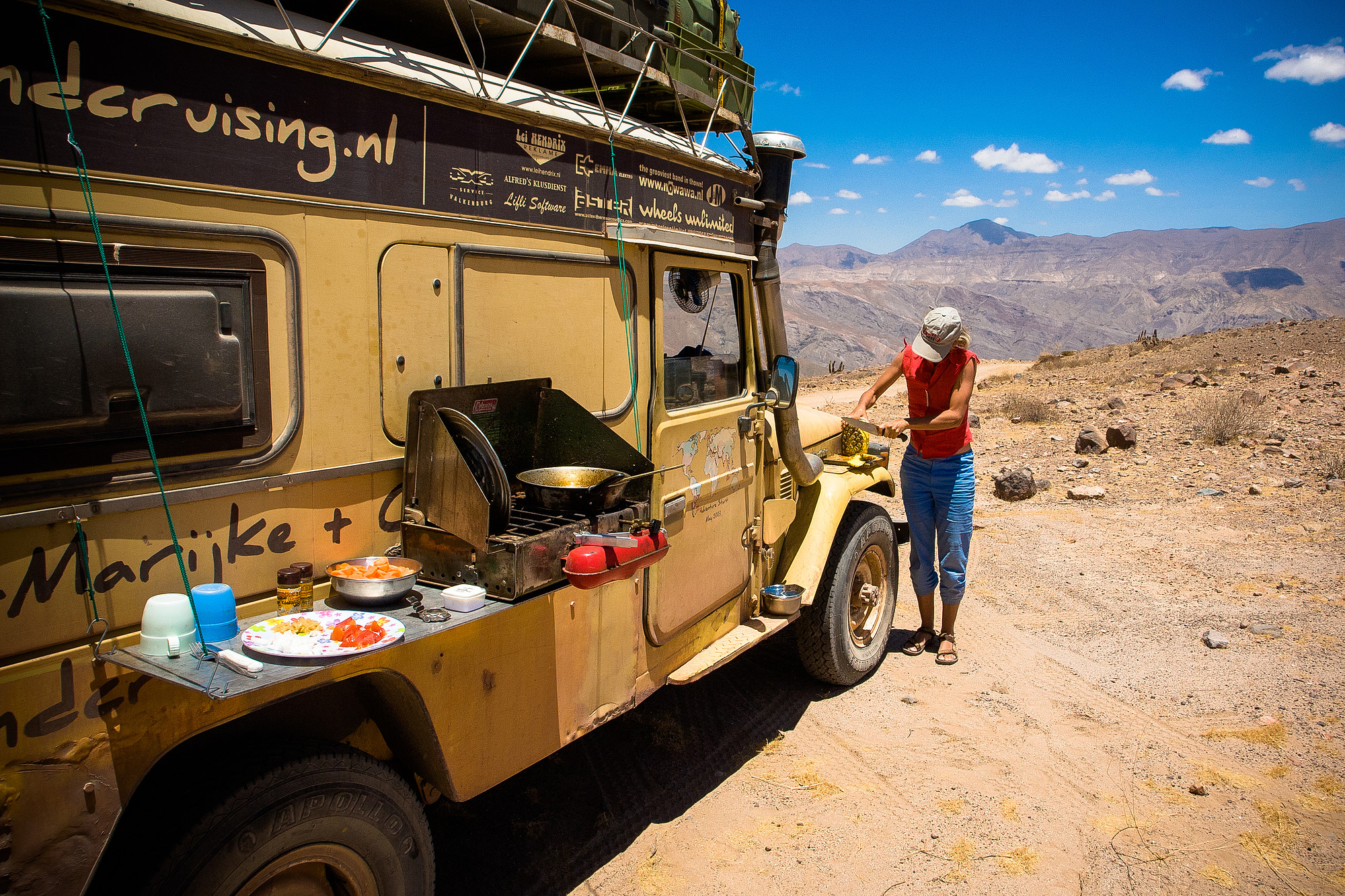

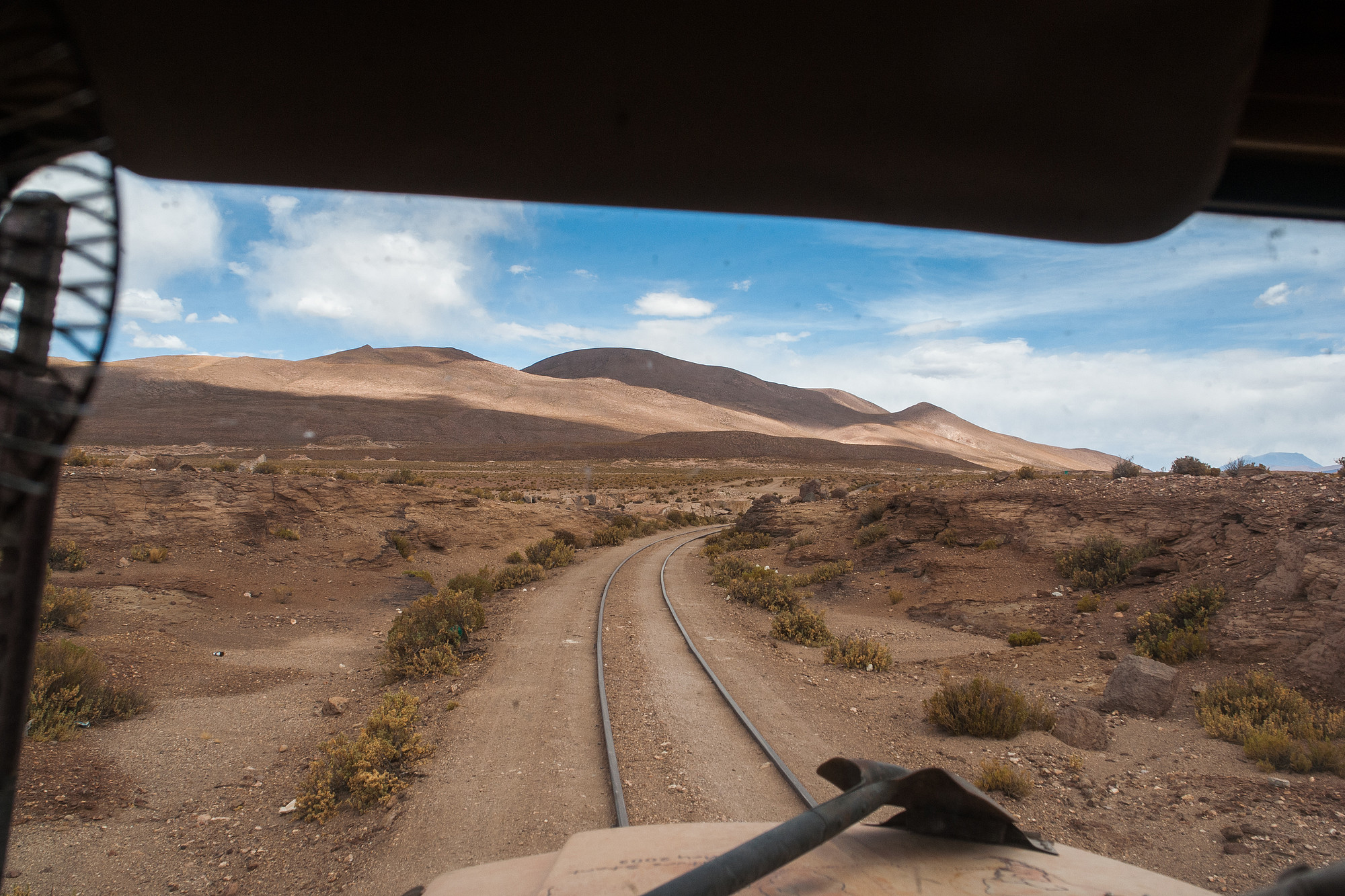
Isluga Volcano National Park
A few weeks earlier we had arrived in northern Chile, coming from Bolivia. After the border crossing we turned right and drove into the Isluga Volcano National Park. Its palette of greens, yellows and browns called out to us. A cemetery lined the road. It was protected by adobe walls with two drums in front of the entrance to prevent llamas from barging in and eating the plastic flowers or doing other damage. Graves had sunk into the soil. They were decorated with half disintegrated wreaths of plastic flowers and many were marked by a wooden cross. The deceased were honored with the burning of a candle, a flower in an empty bottle, a small offering.
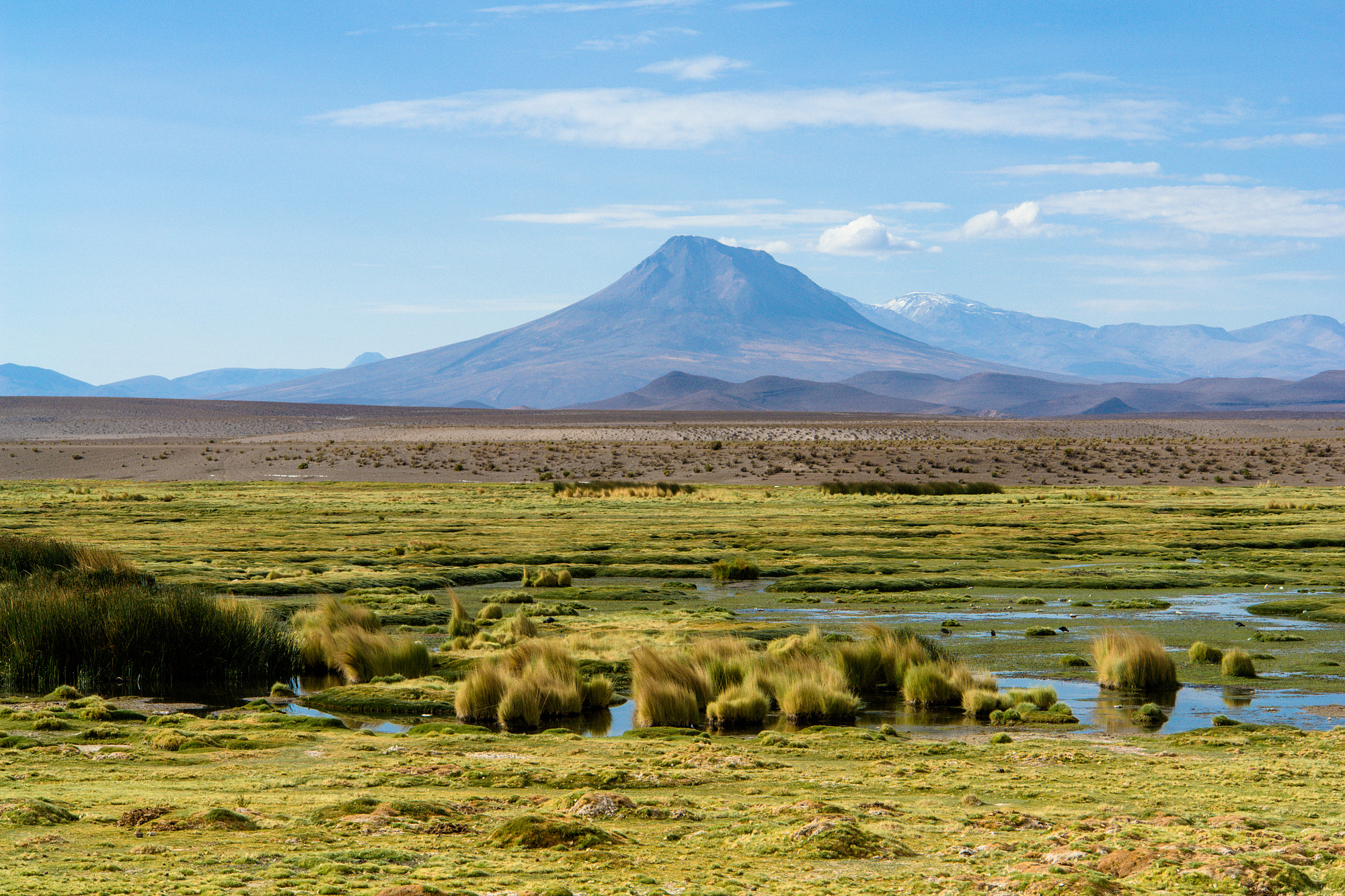
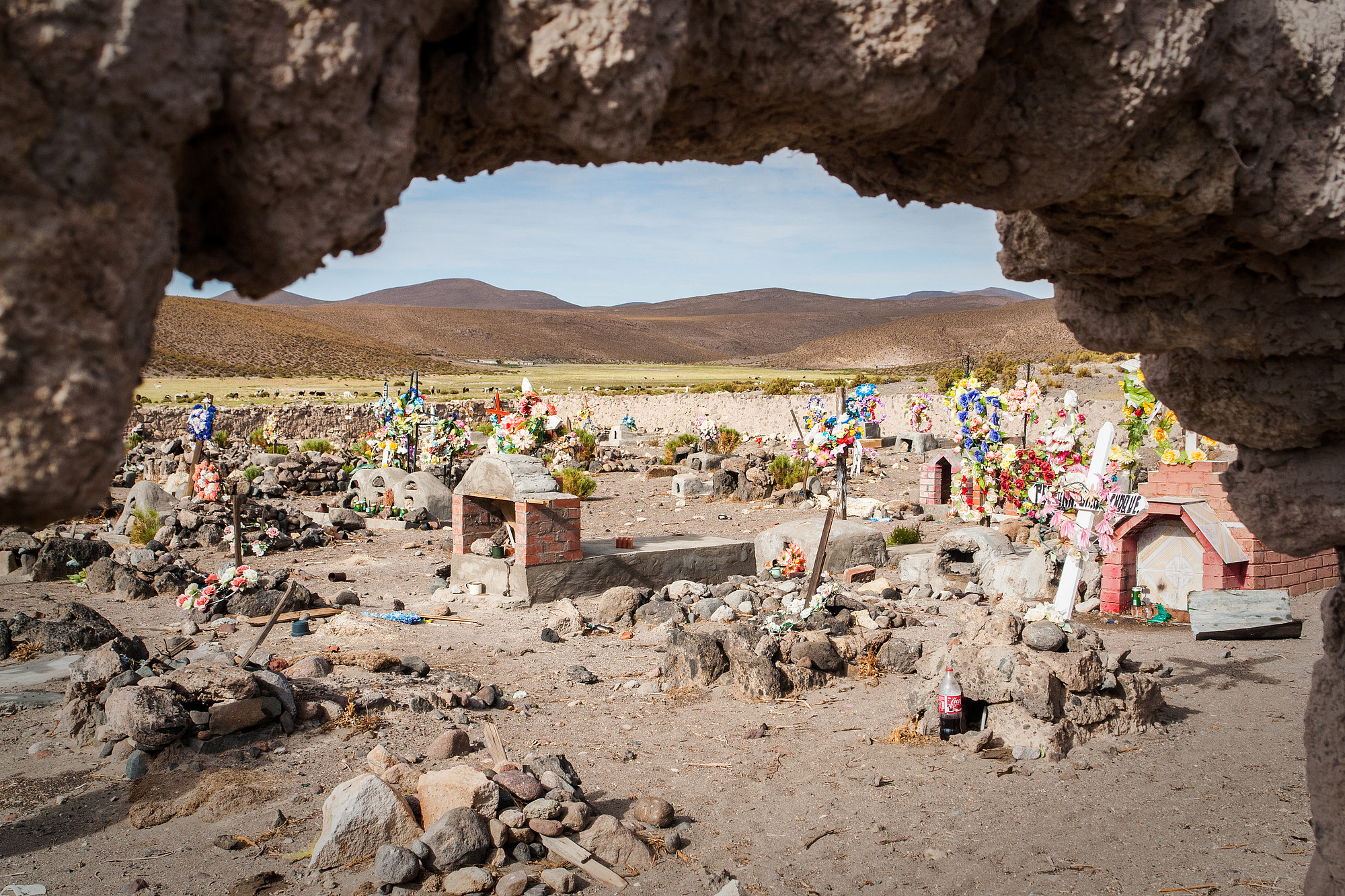
Most adobe houses in Isluga village had corrugated roofs. The ones that still had thatched roofs were falling apart, the beams of dried cactus wood peeking through the holes. Few people lived here. As a result of the booming nitrate industry around 1900, people had moved to the coastal cities of Iquique and Arica. When the industry collapsed, they didn’t return. The Chilean Aymara people continue to live in cities and have left their llamas in the care of Bolivian herders. They return to their ceremonial villages (as they are called) only for special occasions. An important festival is in January/February when young llamas are born. During these fiestas floreas, the owners count and brand the offspring. While the branding is a government requirement, they stick to their own system as well: tying colored strips of cloth to the llamas’ fur to denote ownership.

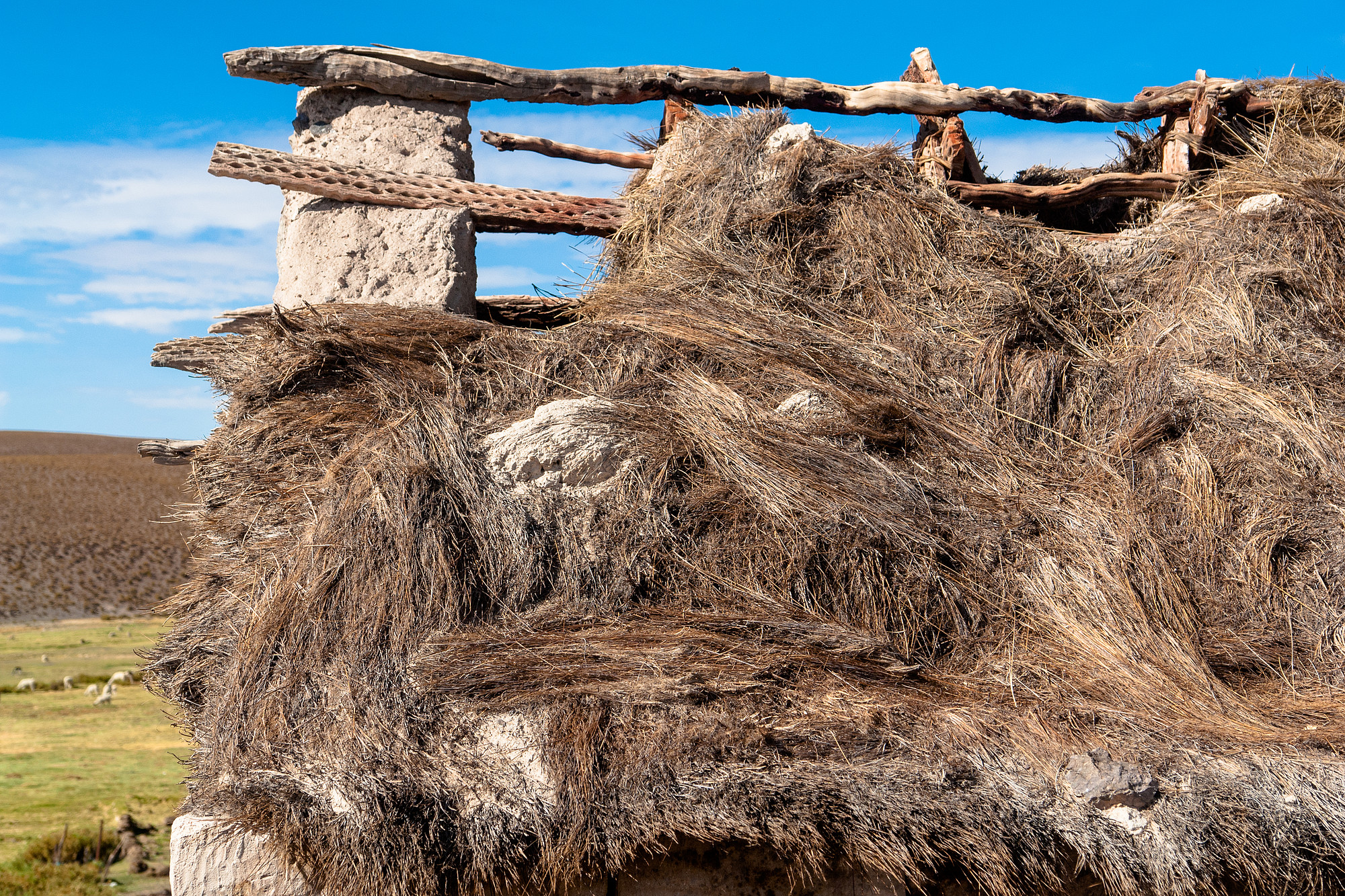
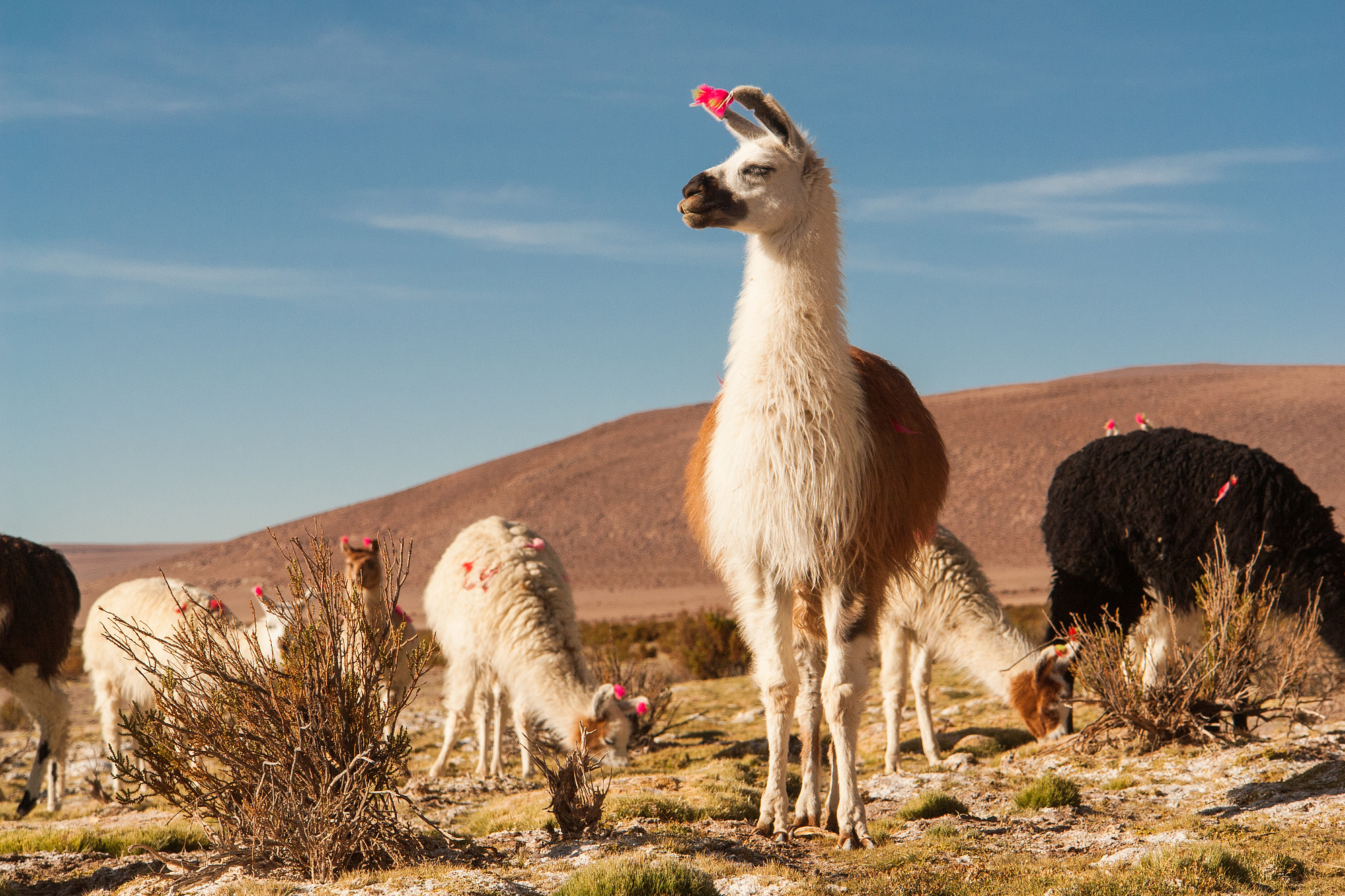
We meandered through the park under a cobalt blue sky with the 18,000-foot-high Isluga Volcano towering in the background. A sliver of black smoke rose from its peak. Road signs had disappeared, but a local had drawn a map for us. The unpaved road snaked its way around brown-gray slopes or followed a bright blue-green river that curved through the dry landscape. Alpacas and llamas grazed on infrequent patches of wild grass or ran alongside the Land Cruiser. At the park’s highest pass, at 15,000 feet, rose a large mound of stones. Around it lay empty bottles and cans, offerings of passersby to Mother Earth (Pachamama). The pass was void of vegetation, but we had descended only a little distance when marram grass dotted the landscape again. Rocks were covered in lloreta compacto. This type of moss takes ages to grow but only a second to disappear. Over time, people have used it as fuel in such large quantities that it is now a protected species.
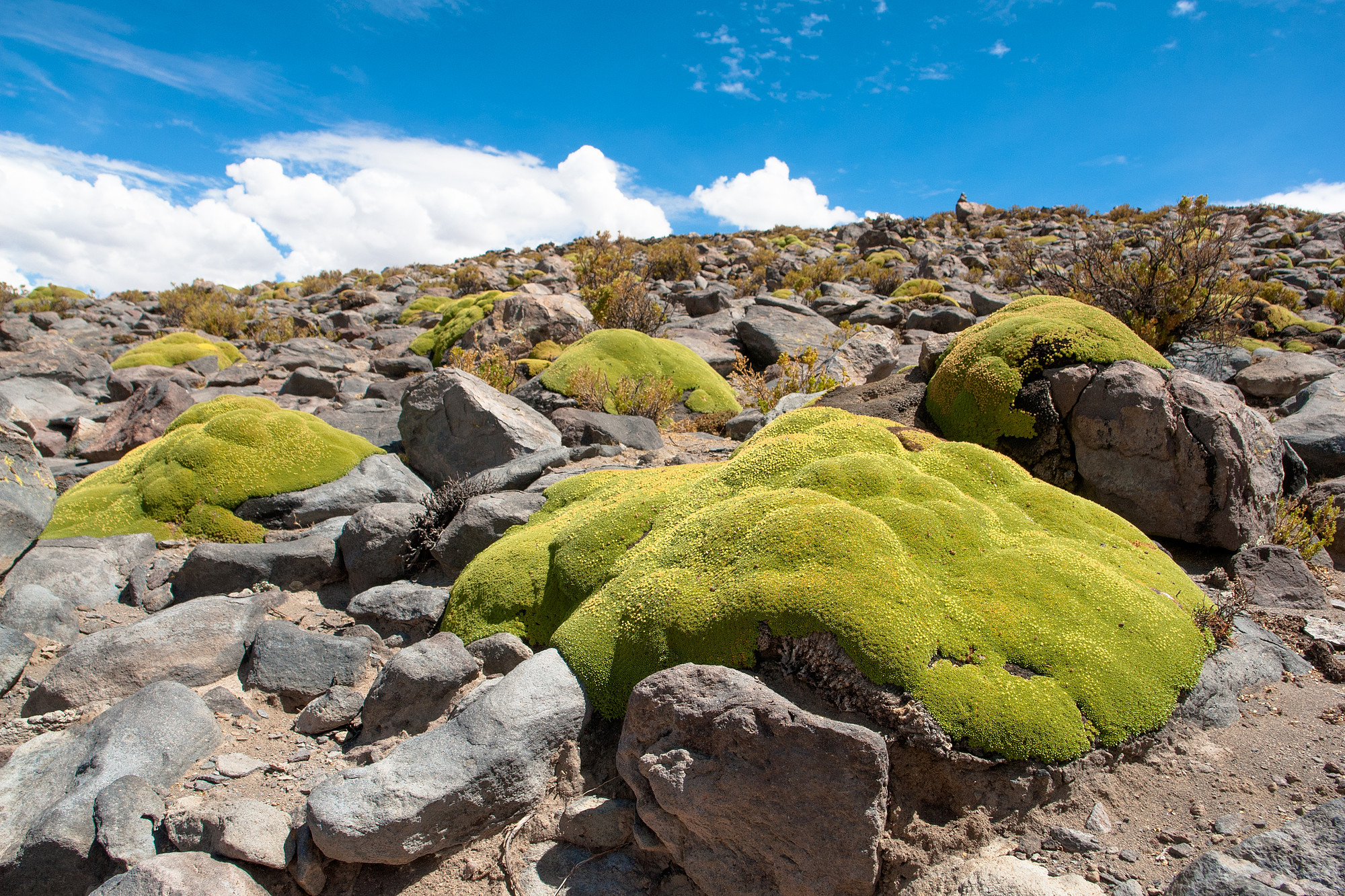
We checked our hand-drawn map. The landmarks seemed to match; the distances between them not at all. The same went for our paper map. As usual, Coen had full confidence in our GPS, and I had full confidence in ourselves. I had stocked up on enough water, food, and fuel to allow for getting lost. The path became a collection of potholes and bumps. It was only a matter of time before the first bolts and screws started plopping around the windscreen. We were used to this sequel of events. We stopped to search for the one that had fallen through the open side window, and its yellow-painted metal made it hard to find in the similarly colored dust. Once again, Coen tightened things where necessary, and we continued our descent.
 From Far Away
From Far Away
A landscape dotted by saguaros made way for agricultural fields as we were exiting the park. Potatoes, corn, onions, garlic, and carrots were cultivated for local communities as well as to feed coastal cities. In the village of Camiña, we took a look at one of Chile’s oldest churches (dating from 1613). Not much remained except a couple of walls. According to a police officer, the last earthquake destroyed the historical site. While Coen took care of our registration (after all, we were in border territory), I got the company of three young boys on their bikes. Big eyes, wide smiles.
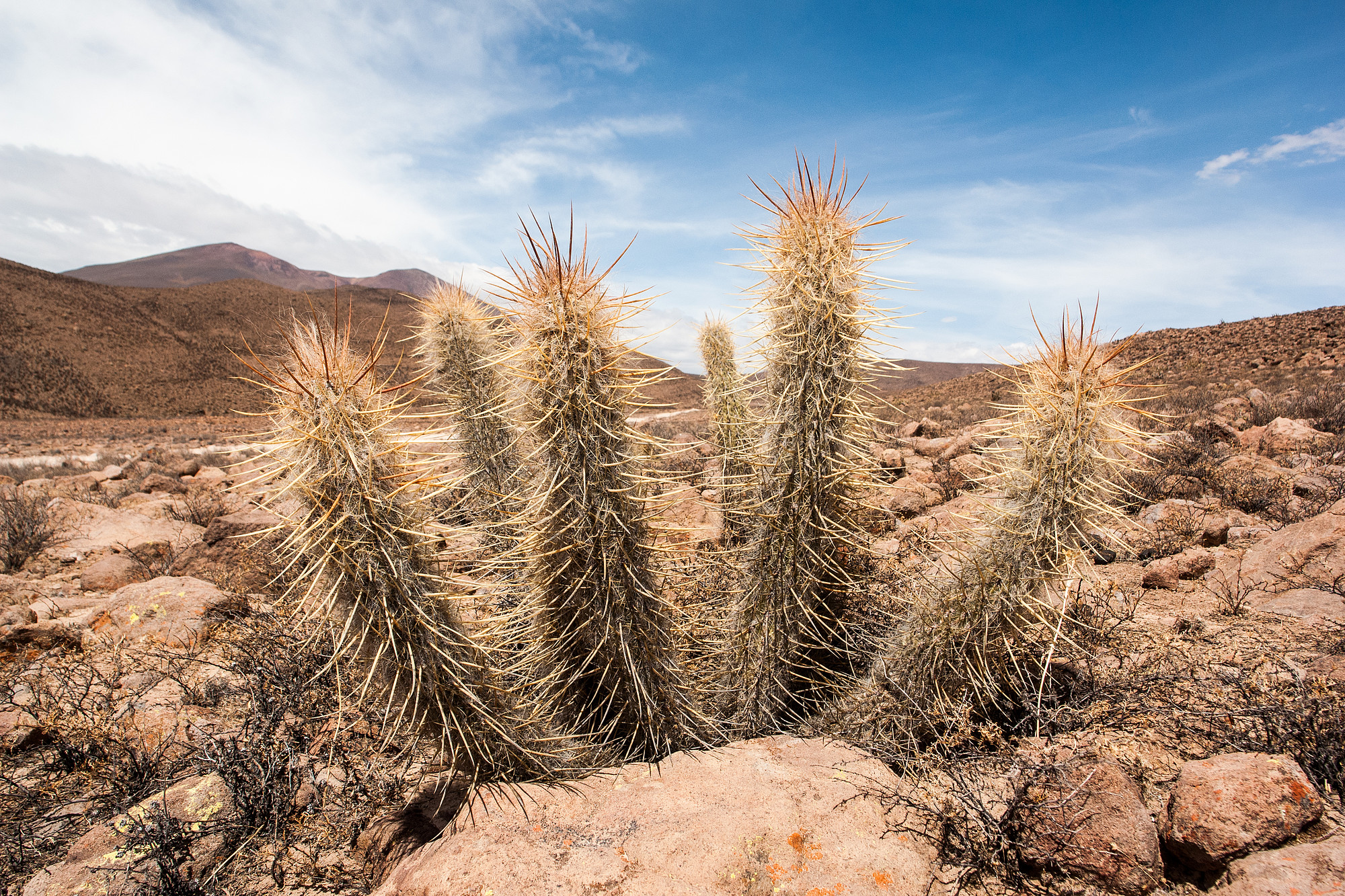
“Where are you from?”
“Holanda.”
That didn’t sound familiar. I tried the magic word that generally works with the male gender throughout the world. “Maybe you know Dutch soccer?”
Nope.
One looked inside. “What flag is that?”
“Argentina.”
Six eyes grew in size. That demanded respect.
“Argentina? That is so-o far!”
“How many hours of driving?” one asked.
“No, not hours. Days. Maybe as many as three!” another answered.
“It is dangerous there. That is why they carry a massive gun,” number three added, looking with respect at our hi-lift.
I explained it wasn’t a gun but a device to lift the Land Cruiser out of the mud.
They circled the car on their bicycles.
“Toyota,” one sighed. He was deeply impressed.
Coen returned.
“Ciao,” I said to the boys.
“What is goodbye in your language?”
“Doei.”
“Doei!” “Doei!” “Doei!”, their cry went through the village as they cycled ahead of us, waiting at each corner and thus guiding us out of this town dominated by one-way lanes.
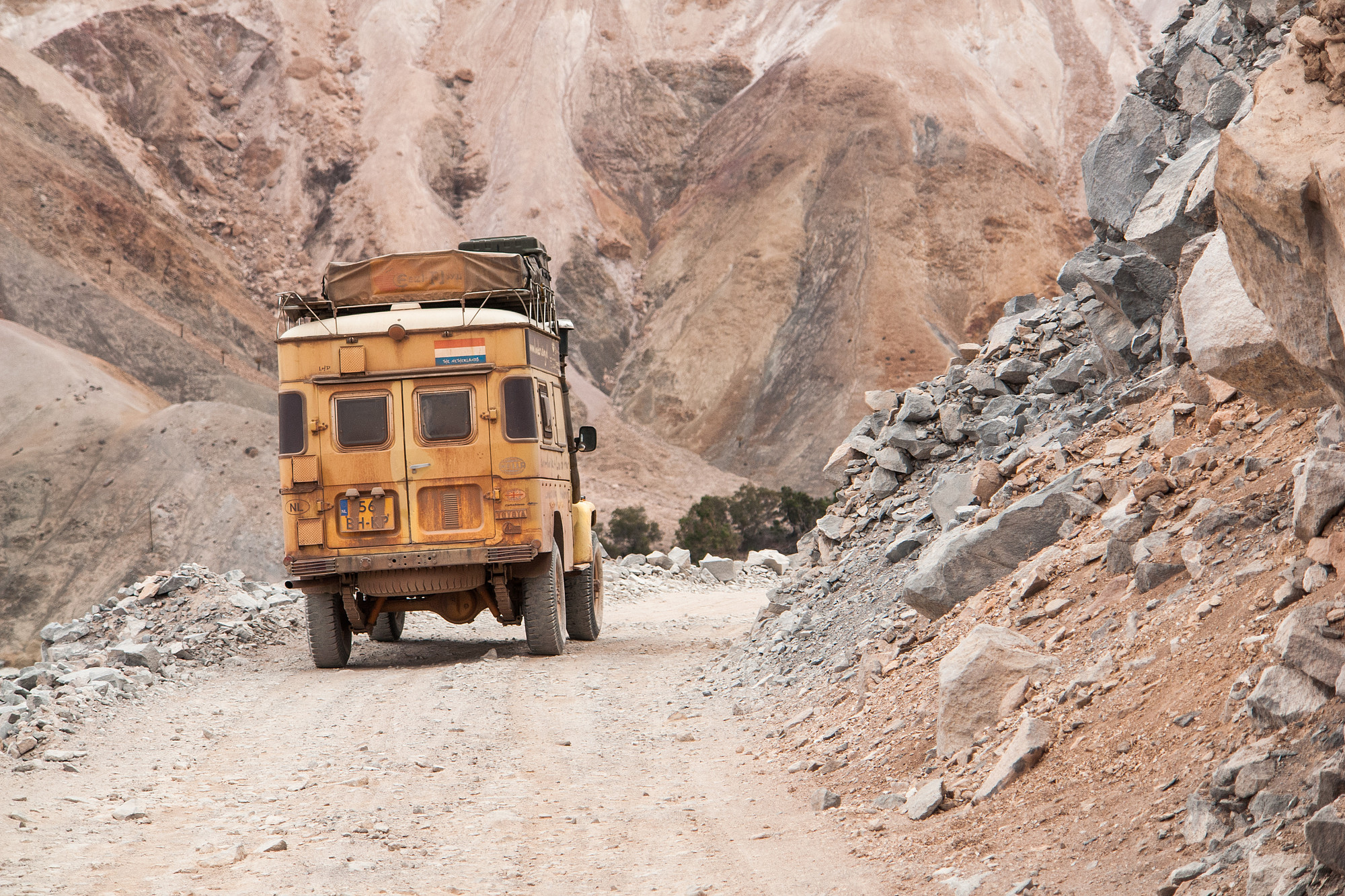
Decay in Pisagua
We set our compass west and cruised over a smooth asphalt road that cut straight through the Atacama Desert, one of the driest deserts in the world. We crossed the Pan American Highway and followed brand-new tarmac that descended between two dunes, the Pacific Ocean visible in the distance. As we got a glimpse of a decayed town, we wondered why friends of ours had recommended visiting Pisagua. The town was a collection of weathered and crumbling buildings, juddering corrugated plates and squeaking hinges. We came across the remains of richly carved wood panels and half-rotten columns that once held verandas in place. Few buildings were maintained, and only a handful were protected as national monuments, among which the clock tower and the old prison. A sign next to the remains of the Nitrate Railway Station stated the prohibition of taking wood from the buildings. A futile sign, as all floors had been removed, as had parts of the walls and doors.
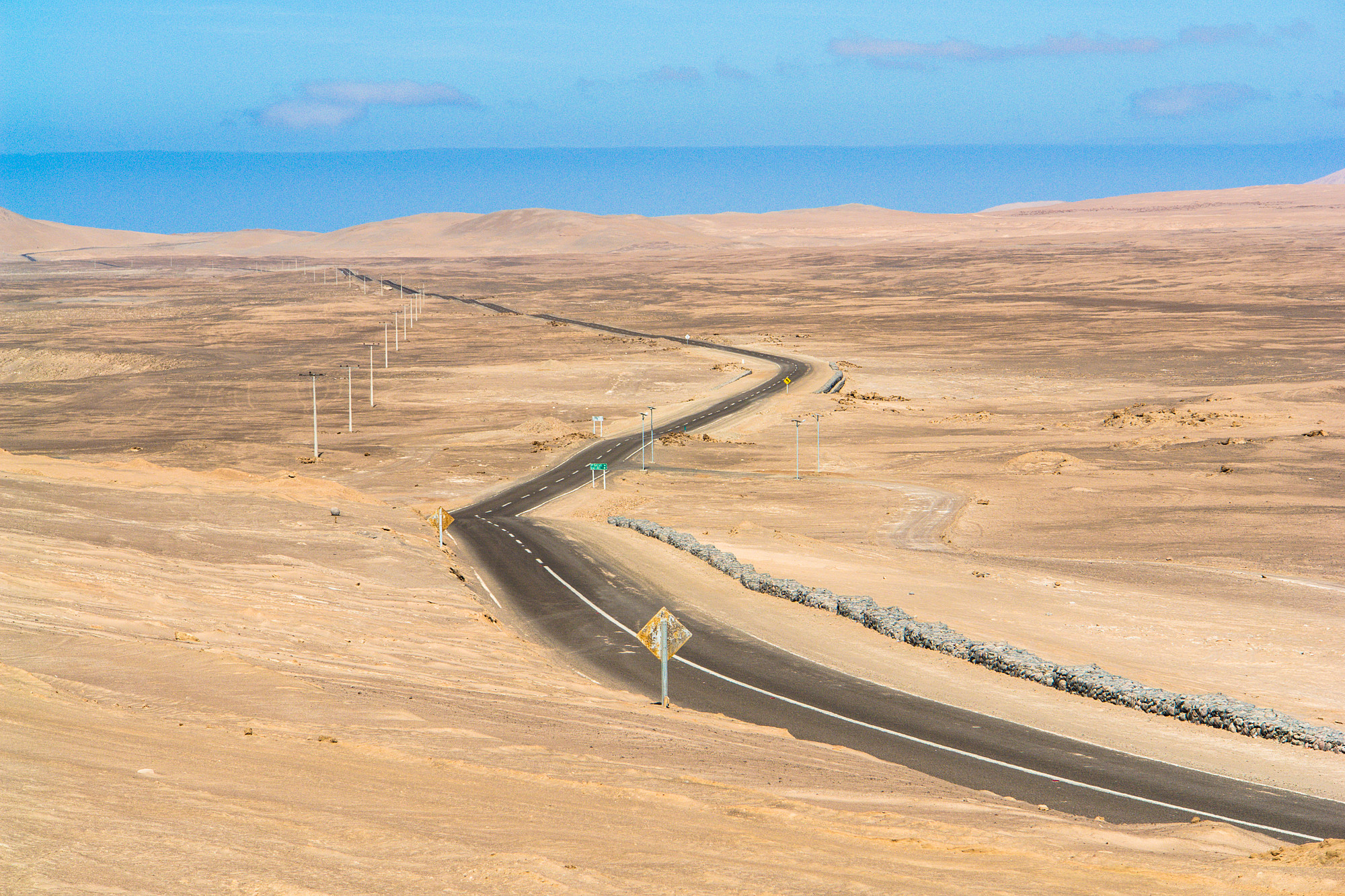
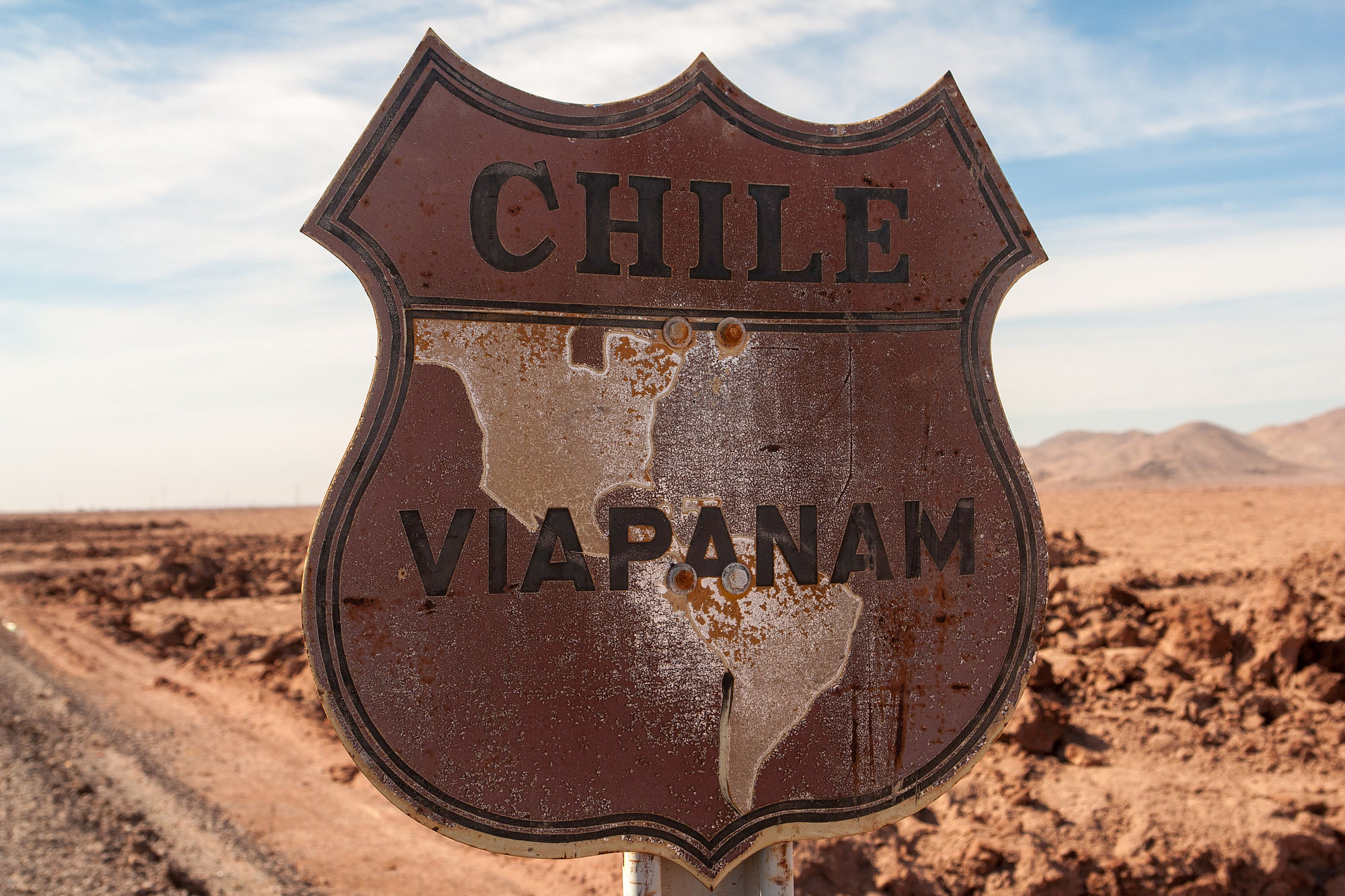
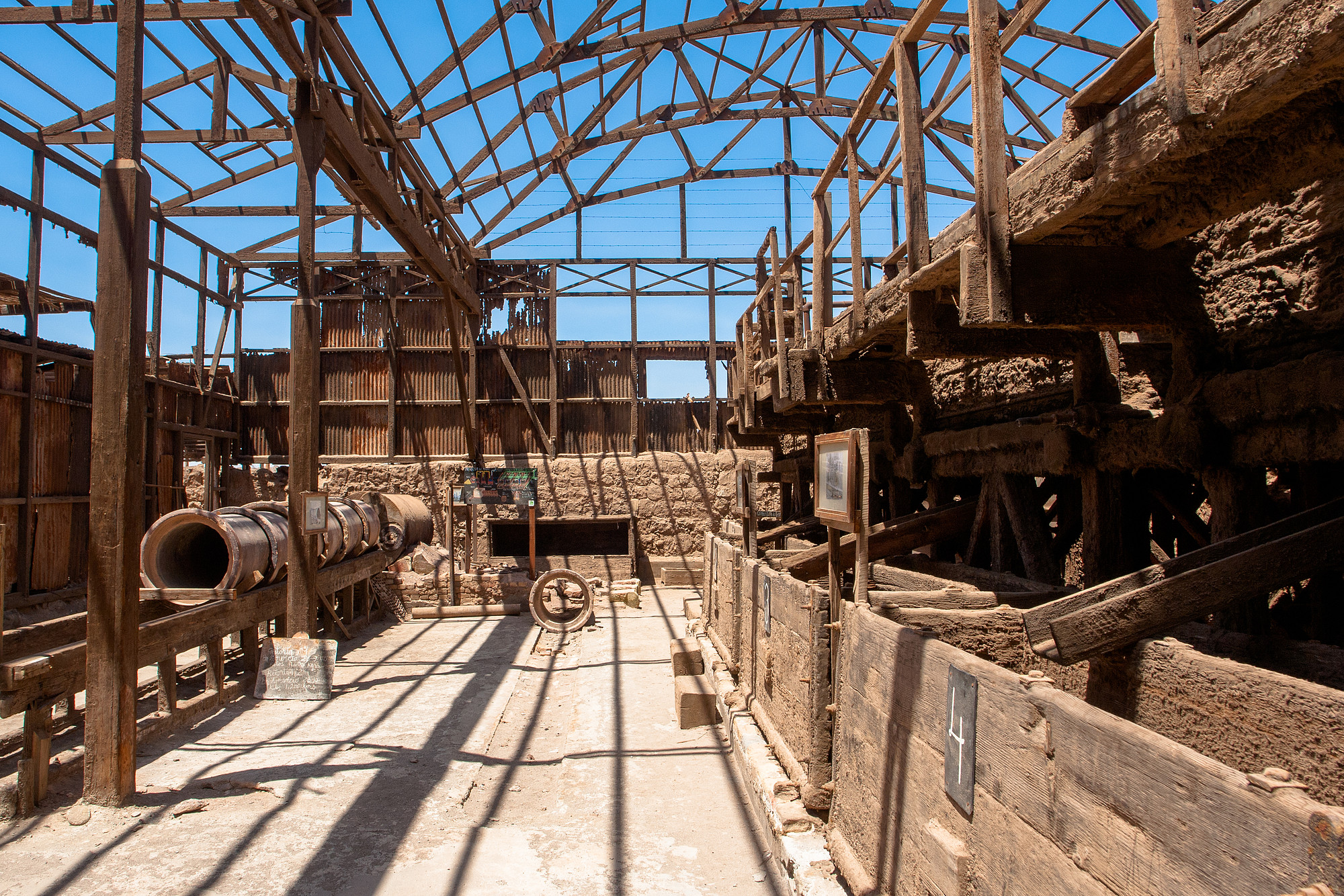
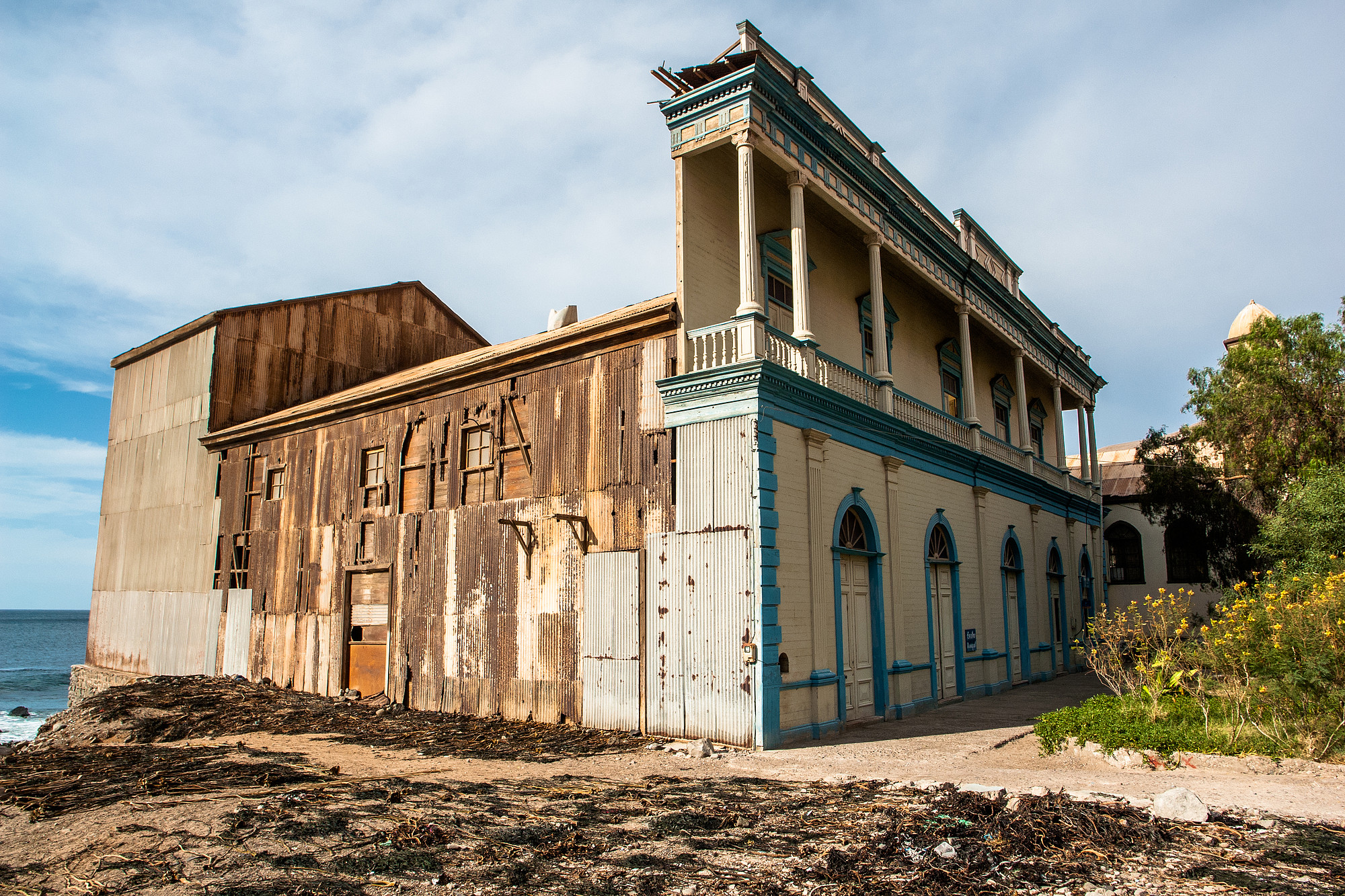
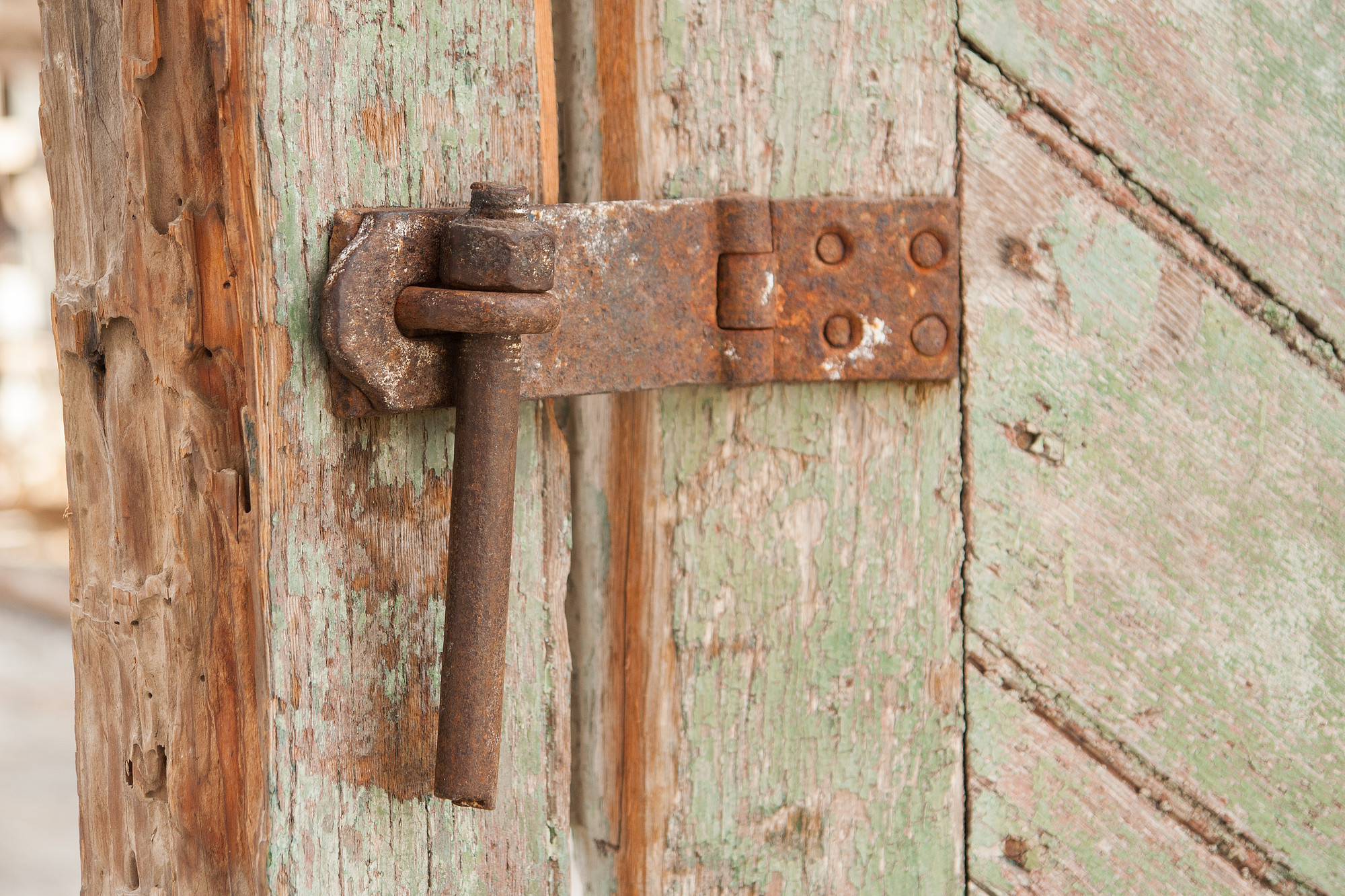 \
\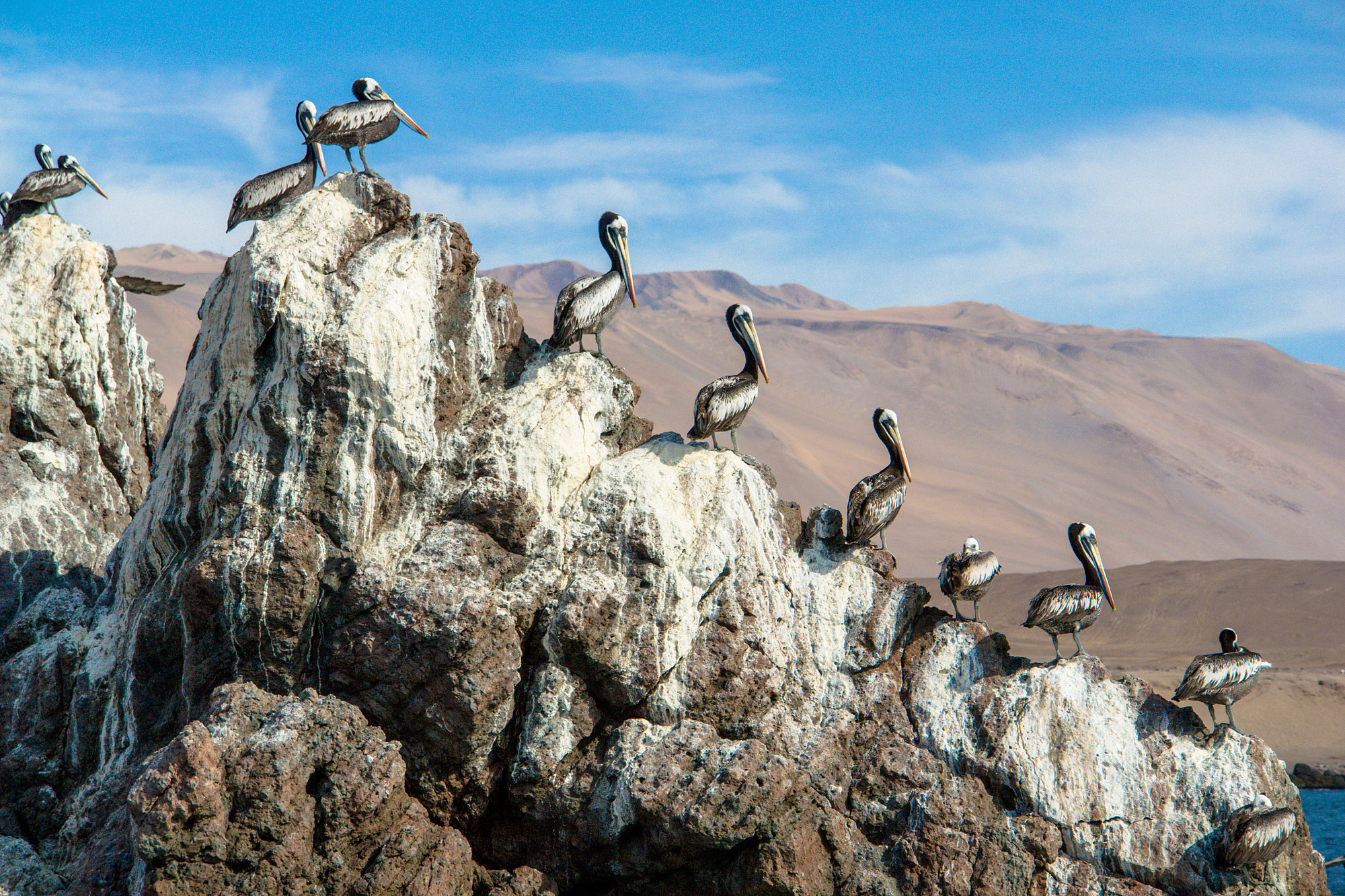
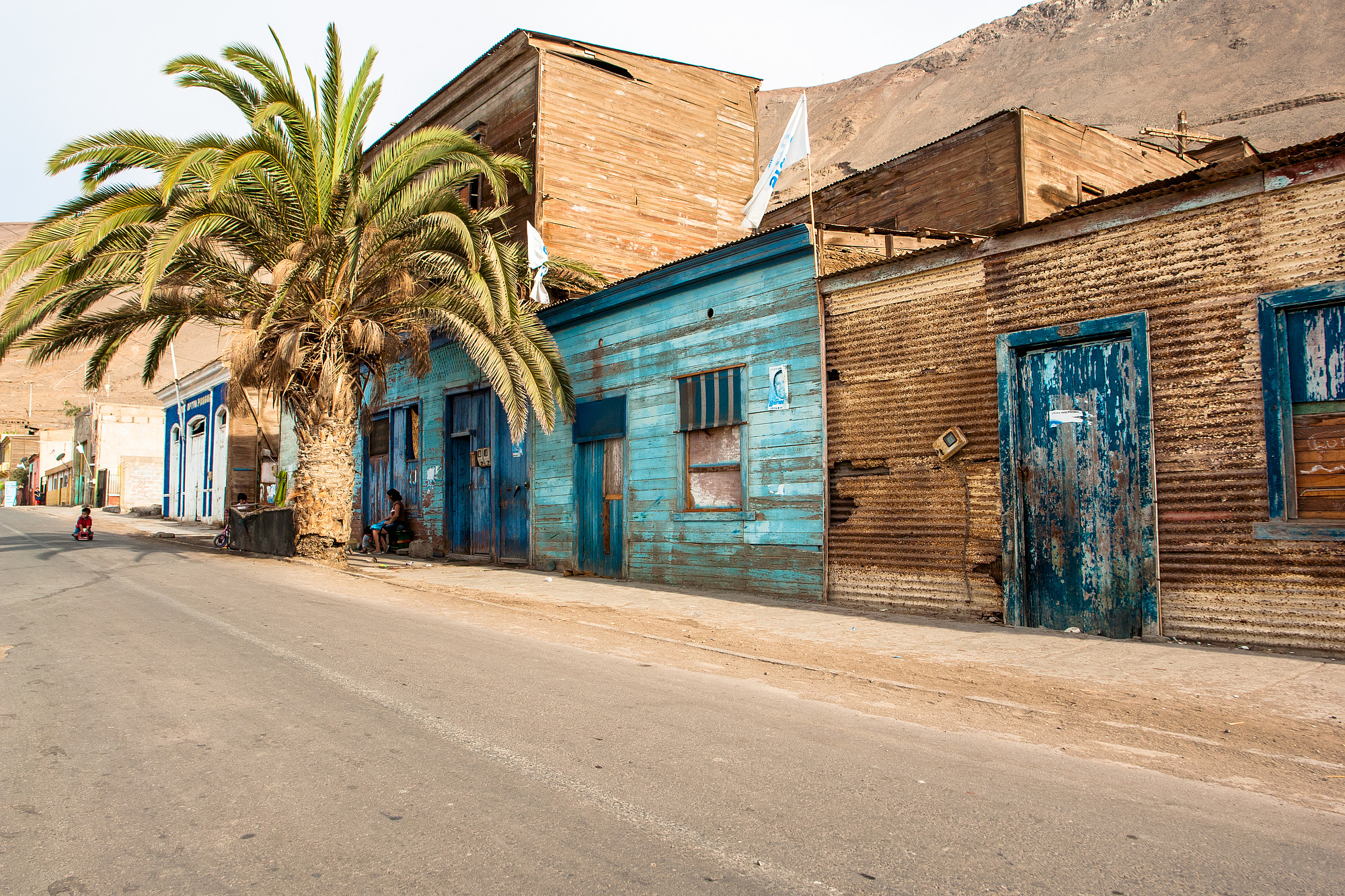
Pisagua is one of those typical towns throughout the world that remind you of the fleeting existence of prosperity. Only a century ago the town had lived through a golden era when nitrate was mined in huge quantities in the surrounding Atacama Desert. At the peak of the nitrate boom, around 1900, 170 mines annually produced 3 million tons of nitrate, creating jobs for 200,000 people. This was one of the ports from which nitrate was shipped across the world. After World War I, the Germans found a way to produce the much cheaper synthetic fertilizer. The town fell into decay, and this part of the Atacama Desert turned into a museum of ghost towns. The nearby UNESCO sites of Humberstone and Santa Laura are the best-preserved testimonies of that bygone era. Besides this century-old history, there was a much more recent tragedy. In the 1970s, Pisagua was one of Pinochet’s torture centers. North of town, somewhat hidden in the dunes, lies the City of Death. The salty sea and wind have weathered the wooden graves marked by crosses or protected by wooden frames. A massive monument stood at the far end. Until 1990, “nobody” knew that a mass grave had been dug here, but thanks to the persisting descendants, the grave was found. It contained bodies that had been tortured and killed in 1973 and 1974. Of the twenty-one political prisoners murdered in Pisagua, seven bodies have never been found.
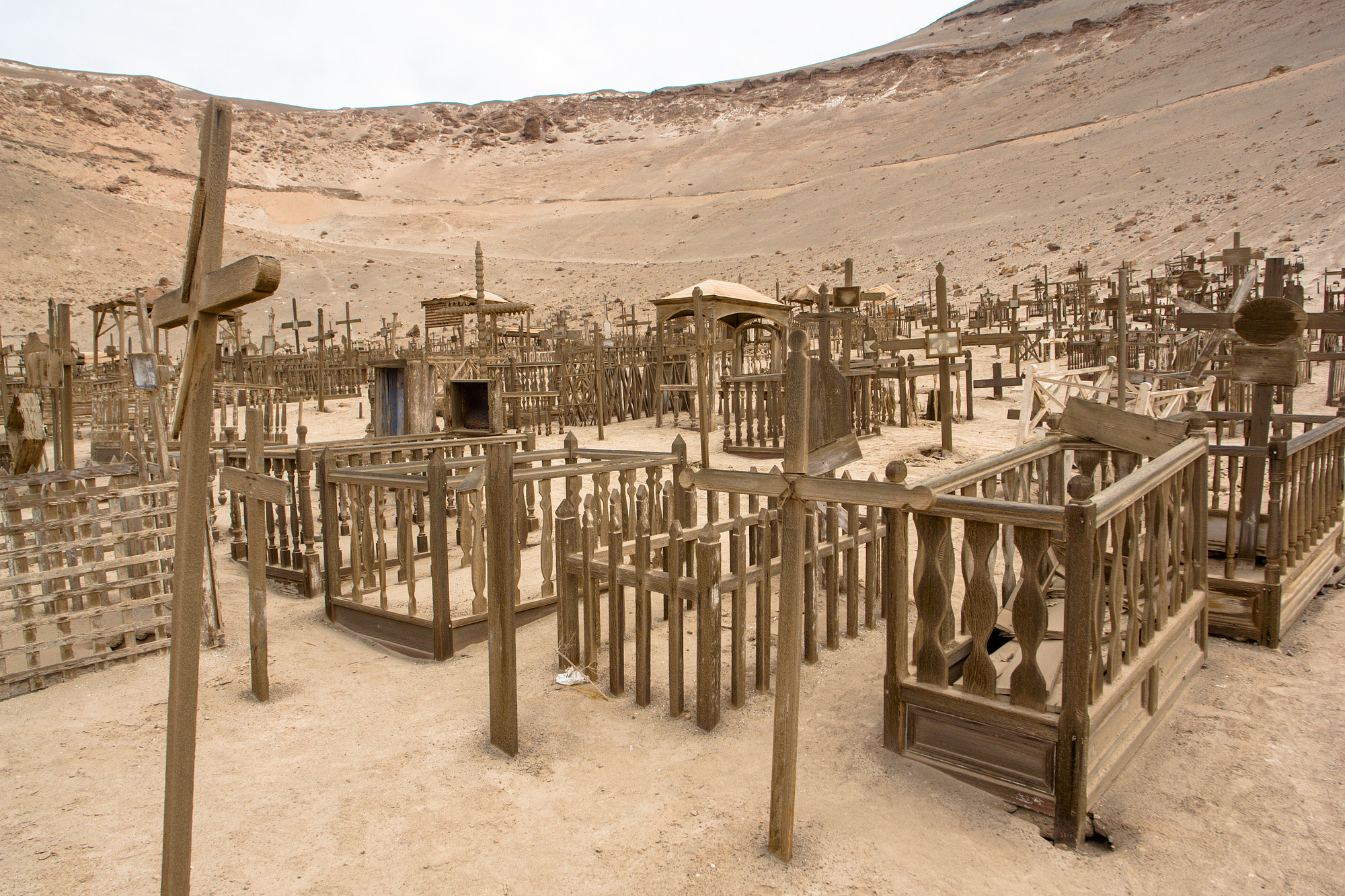
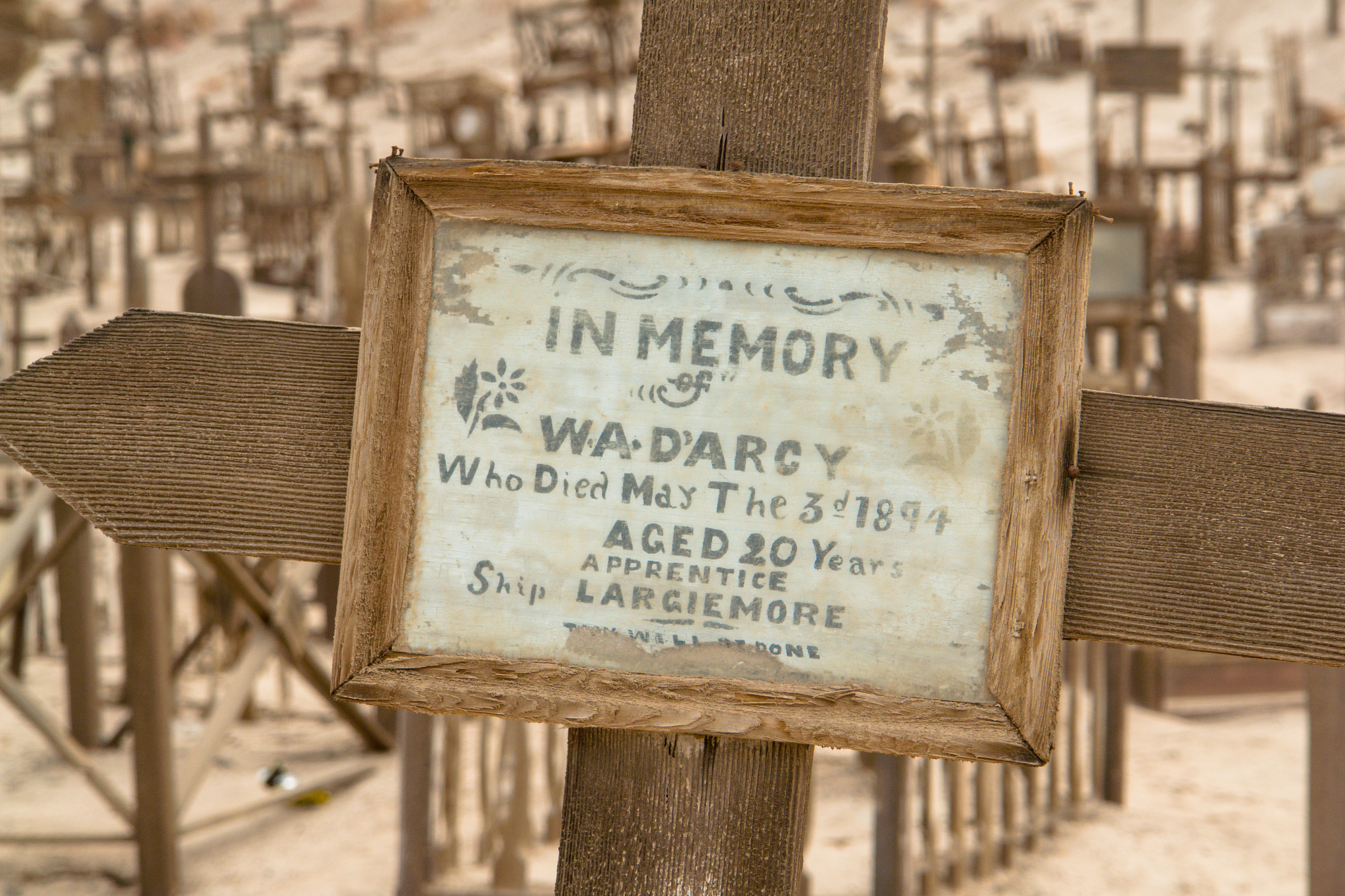
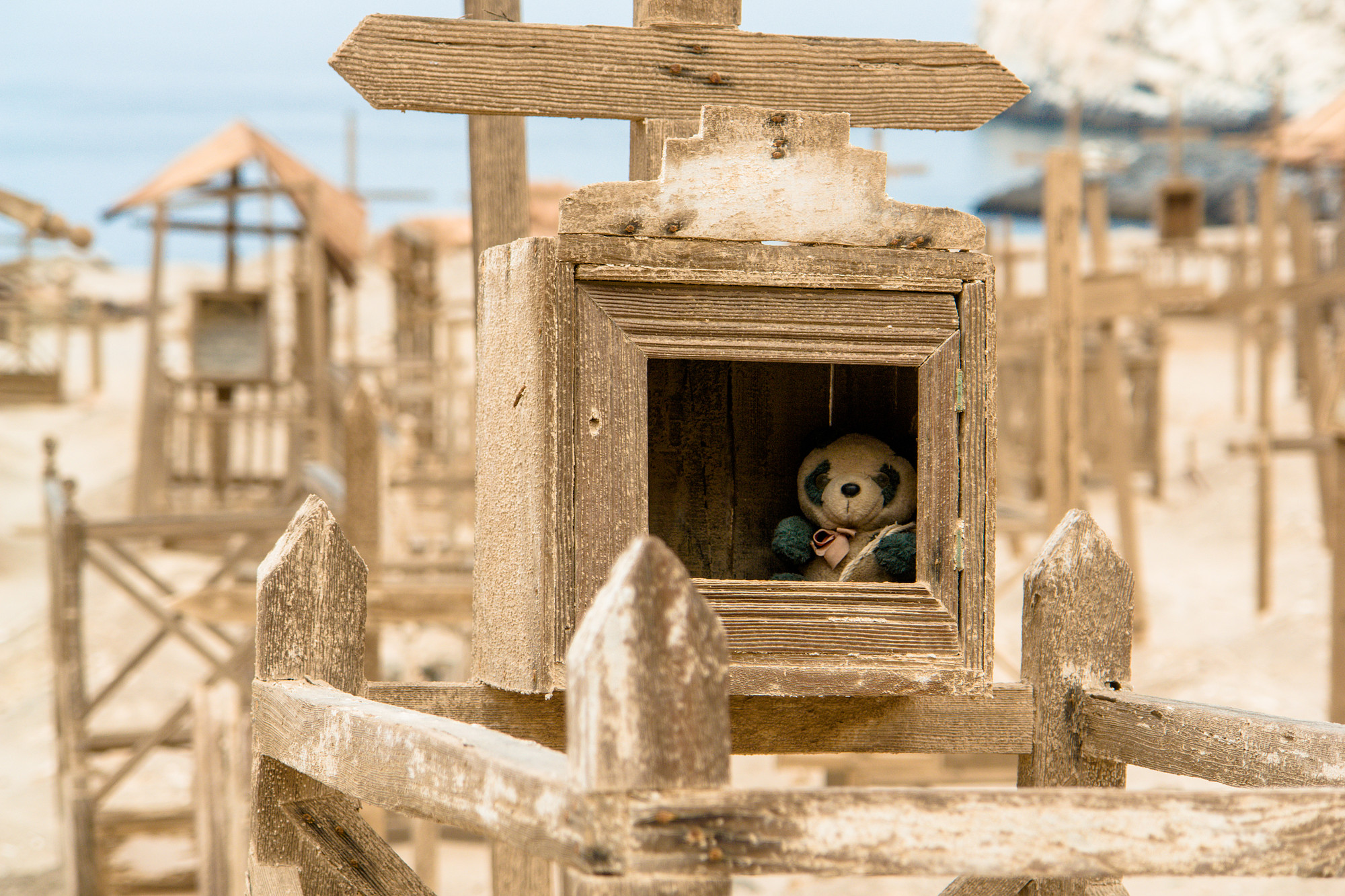
 “Una ciudad triste,” a restaurant owner sighed. “Muy triste,” she emphasized. That pretty much summed it up. Yet, as we strolled around the town, sat on sidewalks and along the shore taking in the views of the ocean and watching pelicans taking a rest on the rocks, we grew to like this place. There was something about Pisagua, intangible but present, and we found ourselves staying longer than anticipated. We understood why our friends had recommended going here.
“Una ciudad triste,” a restaurant owner sighed. “Muy triste,” she emphasized. That pretty much summed it up. Yet, as we strolled around the town, sat on sidewalks and along the shore taking in the views of the ocean and watching pelicans taking a rest on the rocks, we grew to like this place. There was something about Pisagua, intangible but present, and we found ourselves staying longer than anticipated. We understood why our friends had recommended going here.
Camping on Ruins
The few people who have continued to live here depend on fishing. Locals dive as deep as 100 feet to harvest shellfish and crustaceans, without diving suits and with only a long tube to breathe through. Others collect seaweed and dry it on concrete slabs that once belonged to prosperous fishing plants. I suggested we set up camp at the far end of the ruins. On the remains of a concrete floor above the rocky shore we would have a perfect view of the sunset. Coen is the picky one when it comes to camping spots because the Land Cruiser has to be parked super level for him to sleep well. As a result, he generally decides on which inches of any given space the car will be parked for the night. However, this time I insisted on my spot, and he gave in.
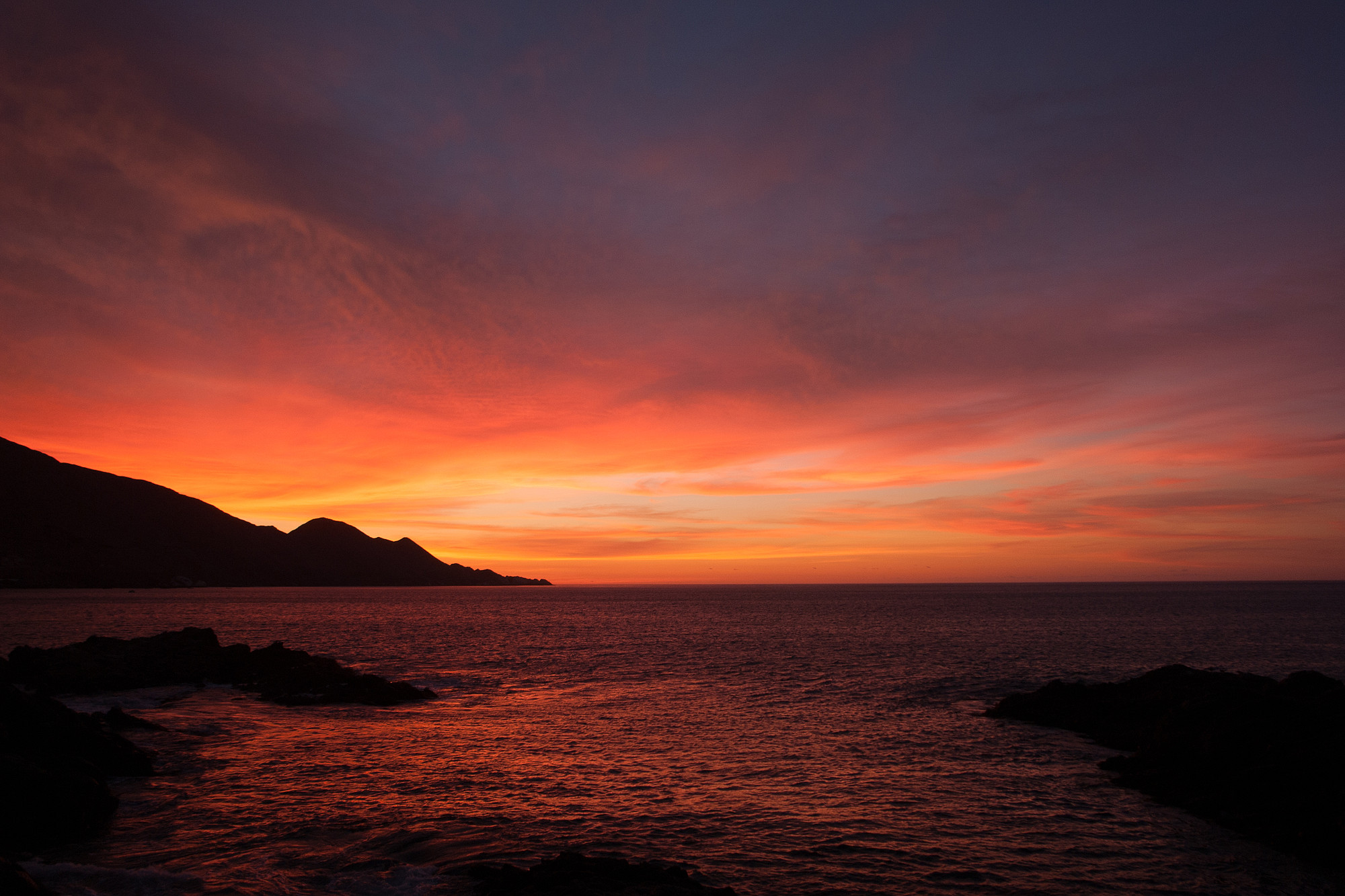
The sunset was fabulous, but I couldn’t sleep. It was high tide, and a storm started raging. While the wind was howling around the Land Cruiser, the waves were growing higher and fiercer, slamming on the ruins around us. I feared the whole place was going to collapse. I moved to the driver’s seat and started the engine. Coen woke up, annoyed.
“What are you doing?!”
I explained.
He laughed at my concern that the car, and we, would be engulfed by the waves.
“Great job,” Coen concluded the next morning when checking out my camping spot, well protected behind a wall away from the waves.
“Our first puncture with these tires,” he added while pointing at a big nail in a deflated tire. I guess I lost my right to determine our camping spot for a while.

Time for a Bath
We meandered along the coast for a bit, but the altiplano was calling, so we headed back inland and drove to the Quebrada Aroma. The gorge was vast, empty, bare, a kaleidoscope of slate gray, red-brown, copper green, and salmon pink. The canyon felt utterly uninhabitable, yet in prehistoric times people had lived here. Around Ariquilda we took a closer look at the geoglyphs, and after having clambered uphill, we came across a selection of painted lizards, scorpions, and four-legged animals. The landscape was bizarre with cacti all of a sudden rising up from the soil. Or trees. Or, just as suddenly, land void of vegetation except for some green along a sliver of water that ran across the bottom of the gorge. Back on the altiplano, asphalt had made way for unpaved road surfaces again. Dust whirled up behind the Land Cruiser. The tailwind sent the dust straight into our open side windows, into our hair and every orifice, clogging our throats and sticking to the sweat on our bodies. It was time for a bath and to sink in the thermal waters of Puchuldiza.


